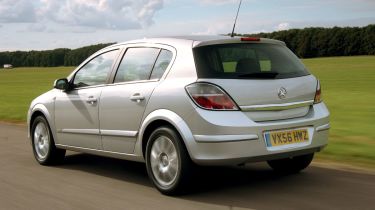Vauxhall Astra 1.6 Life
Mass-market appeal shouldn’t detract from a talented package.
It’s easy to forget how revolutionary the fourth-generation Astra was when it debuted in 2004. The model was a huge step forward in quality, design and refinement over its predecessor. And, as with the outgoing car, it enjoyed substantial sales success – last year, nearly half a million found homes across Europe.
The Astra is such a common sight that it no longer stands out on the roads. But that doesn’t mean it’s not attractive. Details include teardrop rear lights, a shapely tailgate and flared wheelarches. The proportions are better than those of the Subaru or Mazda, too.
The car in our pictures is a Design trim rather than the Life model we tested, and the latter misses out on some sporty details. It features plastic wheel trims instead of alloys, and has black rubbing strips on the doors and bumpers.
Inside, the driving environment is cramped and storage is in short supply. And the layout is ergonomically flawed – as the air vents are at the top of the centre console, switches for the stereo and ventilation systems are awkwardly located low down, while the air-con control is confusing.
However, the quality of the finish is impressive and the materials are the best here. The dash-top plastics, well damped knobs and solid doors all help to create an air of sophistication which is absent from the two Japanese cars.
At 350 litres, the boot appears generous with the seats in place, although its practicality is hampered by a high lip and intrusive rear lights. Further forward, the cabin provides sufficient room for passengers, especially over long journeys, even if the seats aren’t as comfortable as the Mazda’s.
In fact, the Astra isn’t a great motorway cruiser, as tyre roar and wind noise become intrusive; the 3 and Impreza both feel more relaxed. The ride is fidgety at low speed, and uneven road surfaces are more noticeable than in either rival, as the Vauxhall has the firmest suspension here.
The trade-off is good body control through bends and decent composure on country lanes. There are faults, such as the steering, which lacks feel and suffers from kickback through corners. The set-up is well weighted and capable, but less agile and precise than the Mazda’s.
The 1.6-litre VVT engine arrived in the Astra range earlier this year, replacing the Twinport engine. With 113bhp and 155Nm of torque, it’s the most powerful on test – and the noisiest, either when stationary or on the move.
It’s smooth, though, and considerably more punchy than the Subaru, even if there’s little difference between its performance and that of the 1.6-litre unit in the Mazda. At the test track, the Vauxhall was the quickest from 0-60mph, and from 30-70mph through the gears, posting times of 10.1 and 10.0 seconds respectively.
Yet it lost out to the Mazda in our third and fifth-gear acceleration assessments. Still, the VVT unit has the lowest CO2 emissions on test, and proved the most economical of our trio.
With a list price of £13,565, the entry-level Astra is the most expensive car here, carrying a hefty £1,070 premium over the new Impreza. Vauxhall owners lose out on equipment, too – alloy wheels aren’t available, air-conditioning is a £500 cost option and electric windows feature only in the front. What’s more, there are only four airbags, while both competitors come with six. However, the Astra is the only car of our trio that can be specified with stability control.
Details
Price: £13,565
Model tested: Vauxhall Astra 1.6 Life
Chart position: 2
WHY: A hugely popular company car, the competent Astra will be a tough challenge for the Impreza.
Economy
The new VVT is a more economical engine than the Twinport powerplant it replaced at the end of last year. And it makes the Astra more efficient than both rivals. Over the course of the test, it recorded an impressive average of 36.1mpg.
Residuals
The Astra’s popularity counts against it in the used car market, as plentiful supply keeps prices down. A retained value of 31.2 per cent is the worst on test. Over three years, the Vauxhall will shed £9,333, making it worth a mere £4,232.
Servicing
Competitive prices couldn’t stop Vauxhall being listed a lowly 23rd out of 32 dealers in our Driver Power report. However, the 1.6-litre VVT only needs servicing every 20,000 miles – much longer intervals than for either rival.
Tax
No wonder the Astra is a popular company car. Its comparatively low emissions of 156g/km are 20g/km less than the Subaru’s. As a result, even though the car is the most expensive here, lower-band owners will pay £537 a year to run it.


